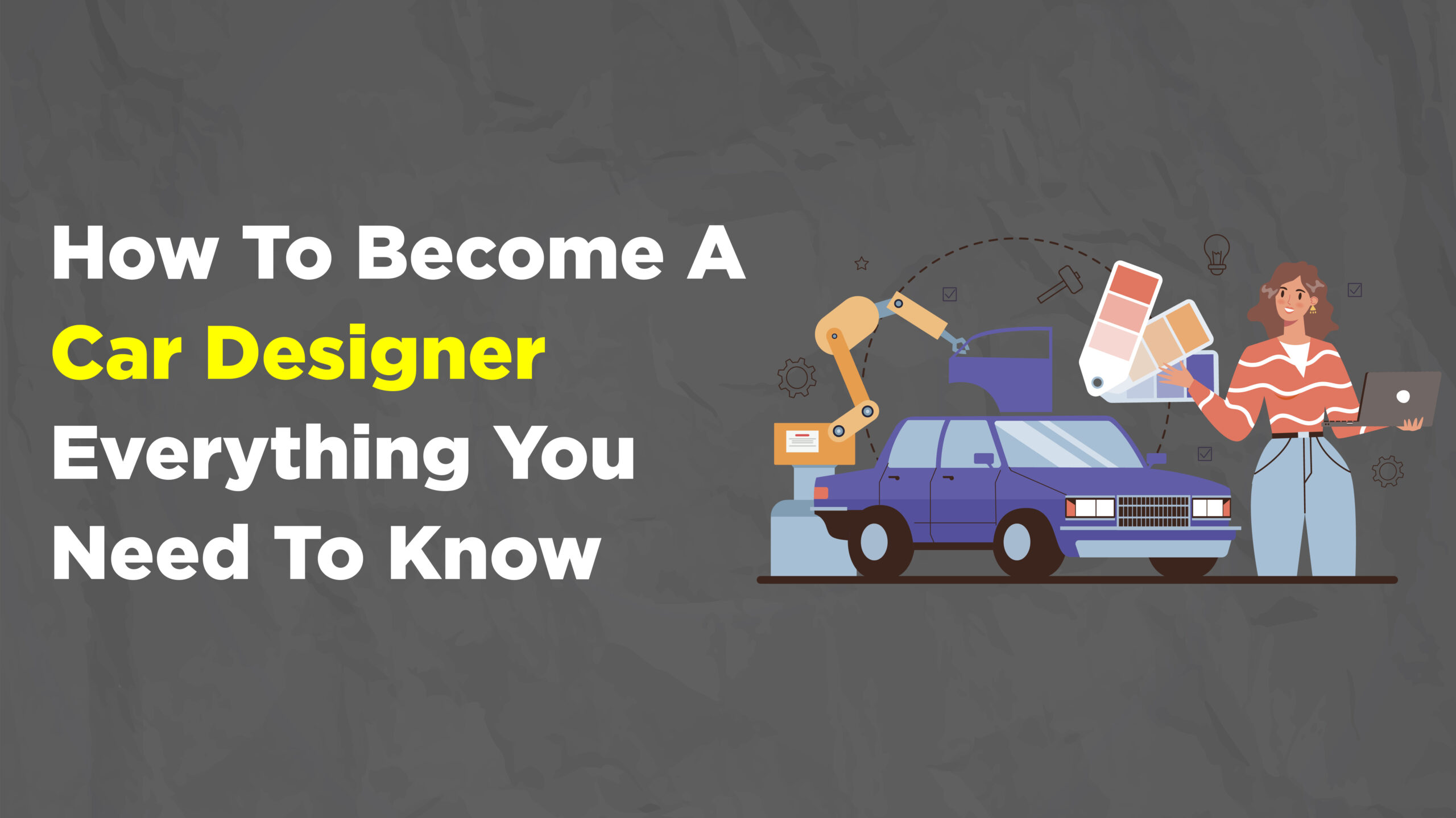The sleek curves of a sports car or the futuristic lines of a concept vehicle – have these ever ignited a spark of inspiration within you? If so, then a career in car design might be the perfect way to turn your passion for automobiles into a fulfilling reality. It’s a field that blends artistic vision with technical prowess, allowing you to contribute to a multi-billion dollar industry and leave your mark on the world, one innovative car design at a time.
This comprehensive guide will be your roadmap to navigating the exciting world of car design. Buckle up and get ready to dive into the details!
The Skillset of a Car Designer
Great car designers are a unique blend of artists and engineers. Here’s a breakdown of the key skills you’ll need to cultivate:
- Artistic Flair:
- A Keen Eye for Aesthetics: You’ll need a strong understanding of design principles like proportion, balance, and harmony to create visually appealing and cohesive car designs. Studying iconic car designs can help you develop this sense of aesthetics. Analyze how different elements like the hood line, wheel arches, and window shapes contribute to the overall visual appeal.
- Sketching Proficiency: The ability to translate your design ideas into captivating sketches is crucial. Mastering foundational sketching techniques like perspective drawing and shading will enable you to quickly iterate and refine your design concepts. Consider taking online courses or attending workshops to hone your sketching skills.
- Color Theory Knowledge: Understanding how colors evoke emotions and influence perception is valuable for creating cars that resonate with target audiences. For example, red is often associated with excitement and performance, while blue can convey a sense of calmness and luxury. Explore color theory resources and experiment with different color palettes to understand their impact on car design.
- Technical Expertise:
- Understanding of Automotive Engineering Principles: Knowledge of vehicle mechanics, aerodynamics (the science of how air interacts with moving objects), and ergonomics (the study of human factors in design) is essential to ensure your designs are not only aesthetically pleasing but also functional and safe. Familiarize yourself with concepts like suspension systems, powertrains, and weight distribution to create cars that handle well and provide a comfortable driving experience. Many universities offer introductory courses in automotive engineering that can provide a solid foundation.
- Materials Science Know-How: Modern car designers must consider a variety of materials like high-strength steel, aluminum alloys, and carbon fiber composites to achieve optimal performance and fuel efficiency. Understanding the properties of these materials, their weight, durability, and how they interact with each other, is vital for designing cars that meet safety regulations and performance goals. Researching current trends in sustainable materials used in car manufacturing can give you an edge in the industry.
- 3D Modeling Skills: Proficiency in industry-standard 3D modeling software like Alias, SolidWorks, and Keyshot allows you to create digital prototypes, refine your designs with greater precision, and collaborate with engineers effectively. The ability to translate 2D sketches into detailed 3D models is a crucial skill in today’s car design landscape. Many universities incorporate 3D modeling software into their car design programs, and there are also online tutorials and courses available.
- The Innovation Spark:
- Creative Problem-Solving Abilities: The ability to think outside the box and propose innovative design solutions that address challenges like fuel efficiency, safety, and passenger comfort is highly sought-after. Consider the ongoing shift towards electric vehicles and design solutions that optimize battery range and minimize environmental impact. Researching emerging technologies like autonomous driving systems and car connectivity can also help you develop innovative design ideas.
- Trend Awareness: Staying updated on the latest design trends, technological advancements, and consumer preferences in the automotive industry is crucial. Explore car design magazines, attend industry conferences, and follow car design blogs to stay informed about the ever-evolving landscape. Understanding consumer preferences, such as the growing demand for spacious interiors and user-friendly technology, will help you design cars that resonate with the market.
- Software Savvy:
- Proficiency in Industry-Standard Design Software: As mentioned earlier, fluency in 3D modeling software like Alias, SolidWorks, and Keyshot is a must-have skill for car designers. Additionally, familiarity with presentation and rendering software like Adobe Photoshop and Keyshot will help you create visually stunning presentations of your designs. Consider the cost and availability of software licenses when making your choices. There might be student discounts or educational licenses available for industry-standard software. Explore free and open-source alternatives like Blender for initial concept development and learning the fundamentals of 3D modeling.
Education and Qualifications
A strong educational foundation is a stepping stone to success in car design. Here are your options:
- Bachelor’s Degree:
- Recommended Programs: A bachelor’s degree in Transportation Design, Industrial Design, Automotive Design, or Mechanical Engineering with a focus on automotive design equips you with the necessary theoretical and practical knowledge to excel in this field. These programs typically include coursework in design fundamentals, sketching, 3D modeling, automotive engineering principles, materials science, and design history.
- Accredited Programs: Look for programs accredited by design organizations like the National Association of Schools of Art and Design (NASAD) or engineering accreditation bodies like the Accreditation Board for Engineering and Technology (ABET) to ensure you receive a high-quality education that meets industry standards.
- Top Universities (US & International): The College for Creative Studies, ArtCenter College of Design, Rhode Island School of Design, Pratt Institute, and Savannah College of Art and Design consistently rank high in car design programs (US). Explore prestigious design schools like the Royal College of Art (UK), Politecnico di Milano (Italy), and Pforzheim University (Germany) for a global perspective.
- Portfolio Power:
- Build a Strong Online Portfolio: Showcase your best sketches, 3D models, design projects (including school projects that demonstrate your design process), and any relevant awards or recognition you’ve received. Consider creating a website specifically for your design portfolio or utilizing online platforms like Behance.
- Tailor Your Portfolio to Specific Job Applications: Highlight projects that demonstrate the skills and experiences most relevant to the desired position. For example, if applying for an interior design position, showcase your strongest car interior design projects that emphasize user experience and ergonomics.
- Internships:
- Gain Invaluable Real-World Experience: Securing internships at automotive design studios or car manufacturers is a crucial step to understanding the professional car design workflow. Here’s a step-by-step method for landing an internship:
- Research Car Design Studios and Manufacturers: Identify companies whose design philosophy aligns with your interests. Research their internship programs and application requirements.
- Make Resume and Portfolio: Tailor your resume to highlight relevant skills and experiences gained through coursework and personal projects. Showcase your best design work in your portfolio, focusing on projects that demonstrate your design process and problem-solving abilities.
- Network and Apply: Attend industry events and conferences to connect with car design professionals. Utilize online platforms like LinkedIn to reach out to recruiters and designers at your target companies. Apply for internship positions well in advance of the deadline.
- Prepare for Interviews: Research the company and the specific internship you’re applying for. Be prepared to discuss your design process, favorite car designs, and your career goals. Showcasing your passion and enthusiasm for car design can make a positive impression.
- Gain Invaluable Real-World Experience: Securing internships at automotive design studios or car manufacturers is a crucial step to understanding the professional car design workflow. Here’s a step-by-step method for landing an internship:
Job Market and Career Paths
The car design industry is competitive, but with talent, dedication, and a strategic approach, you can carve your niche. Here’s what to expect:
- Landing Your Dream Job:
- Research Car Design Studios and Manufacturers: Understand their design philosophy, target markets, and types of vehicles they specialize in. Aligning your skills and interests with the company culture can increase your chances of landing your dream job.
- Tailor Your Resume and Portfolio to Each Position: Highlight the skills and experiences that directly address the specific needs and requirements mentioned in the job description. Quantify your achievements whenever possible (e.g., “reduced design iteration time by 20% through improved 3D modeling techniques”).
- Network with Industry Professionals: Building relationships with car design professionals at industry conferences and events can open doors to potential job opportunities and mentorship. Consider joining professional organizations like the Society of Automotive Engineers (SAE) to connect with like-minded individuals in the field. Social media groups dedicated to car design can also be a valuable networking tool.
- Career Paths:
- The world of car design offers various specializations, allowing you to find an area that perfectly aligns with your interests and strengths. Here are some popular options:
- Exterior Design: Focuses on the car’s exterior aesthetics, including body lines, proportions, and overall visual appeal.
- Interior Design: Specializes in designing the car’s interior layout, ergonomics, user experience, and comfort features.
- Concept Design: Conceptualizes futuristic and innovative car designs, pushing the boundaries of form and function.
- Color and Trim Design: Selects and applies color palettes, materials, and finishes to the car’s interior and exterior to create a cohesive and aesthetically pleasing look.
- User Experience (UX) Design: Integrates user-centered design principles to create intuitive and user-friendly car interfaces and infotainment systems. As cars become increasingly connected and autonomous, UX design will play a critical role in shaping the future of car interiors.
- Never Stop Learning:
- The automotive industry is constantly evolving, with advancements in technology, sustainability, and consumer preferences. Stay updated by:
- Reading Industry Publications and Attending Conferences: Subscribe to car design magazines, follow industry blogs, and attend conferences and workshops to stay informed about the latest trends in electric vehicle design, autonomous driving systems, and sustainable materials.
- Taking Online Courses: Explore online courses on emerging technologies like virtual reality (VR) applications in car design or artificial intelligence (AI) for user interface development. These skills can give you a competitive edge in the job market.
- Participating in Design Competitions: Many car design studios and manufacturers host design competitions. Participating in these competitions allows you to showcase your talent, gain recognition, and potentially land an internship or job opportunity.
- The automotive industry is constantly evolving, with advancements in technology, sustainability, and consumer preferences. Stay updated by:
- The world of car design offers various specializations, allowing you to find an area that perfectly aligns with your interests and strengths. Here are some popular options:
Additional Tips and Resources:
- Building a Strong Network: Connect with other car design enthusiasts and professionals online through forums, social media groups dedicated to car design, and professional networking platforms like LinkedIn. Attending industry events allows you to network in person and build valuable relationships.
- Develop Strong Communication Skills: The ability to effectively communicate your design ideas, collaborate with engineers and other team members, and present your work clearly and concisely is crucial for success. Hone your presentation skills and practice explaining the thought process behind your designs.
- Car Design Tools: Explore free and paid car design software options to practice your 3D modeling skills and experiment with design concepts. Here are some options to consider:
- Free Software: Sketchbook (for initial sketching and concept development), Blender (a powerful open-source 3D modeling software)
- Paid Software: Industry-standard options like Alias, SolidWorks, and Keyshot offer advanced functionalities for professional car design. Consider student discounts or educational licenses for these programs.

